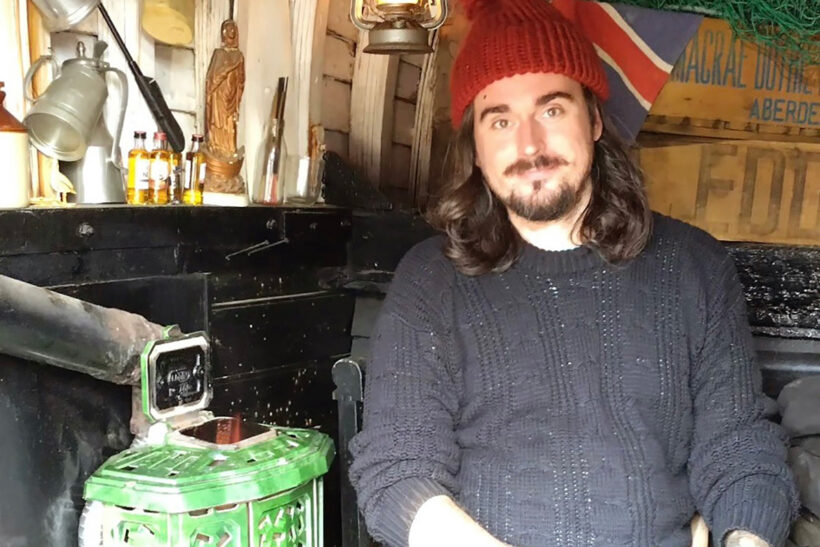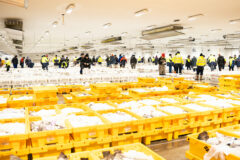“This is my favourite ever museum. I’ve always loved this museum since from when I was growing up,” Stephen Roberts-Pratt, manager and ship-keeper at Hasting Fishermen’s Museum, told Fishing News. “I’m always here on my days off doing bits. It doesn’t feel like a job – it’s a way of life.”
Based inside the former fishermen’s church of St Nicholas – a stone’s throw from Hastings seafront – Hastings Fishermen’s Museum is a small, independent museum which features in its impressive collection a number of clinker-built fishing vessels dating from the 1800s to the 1960s, as well as a large variety of photographs, paintings, models and many other artefacts.
“I was born in Portsmouth, and the maritime history of my family is huge. My grandad worked with the Royal Navy, and my uncle was in the merchant navy and went on to be the harbour pilot for Southampton and Portsmouth. When growing up, my homework every week was learning different knots and flags from the international flag code from my grandad. He was quite strict about that – that’s still embedded in me.”
Stephen started his career with English Heritage, and went on to work at a number of historically important venues, including Portchester Castle, Queen Victoria’s Osborne House on the Isle of Wight
and the Royal Navy Museum at Portsmouth Historic Dockyard.
In September this year, he joined Hastings Fishermen’s Museum. His role encompasses a diverse range of tasks – with no two days the same.
“During the winter we’re open from 11am to 4pm. The first task of the day is to open up the net shops – which are open to the public. I also open up the cottage outside, and then the museum.
“I work out a list of jobs to do during the week ahead. The jobs on that list do vary. It’s all very weather-dependent at the moment, and I have a list of outside tasks and another of more admin-based or indoor tasks which I need to do.
“A lot of my job is the ship-keeper role – which is the maintenance side of things, looking after the boats and the outside exhibitions. This week, for example, I’ve mainly been working on getting everything ready for winter. I’m going to be sanding and repainting one of the fishing boats, and getting that covered and ready for winter – that’s going to take me most of the week.
“We have the old net shops to look after as well, and I’ve also been working on Half Sovereign’s Cottage – which is half of a fishing boat upturned, which I’ve turned into a little house, like there used to be in the 1900s when fishermen lived in upturned boats on the beach.
“And last week I was mainly fixing oil lanterns. We have about 50 here which we’ve collected. I’m getting those working again ready for Christmas, as I want to fill the museum with all the different types of oil lamps.”

Stephen’s role sees him take on a diverse range of tasks, from desk-based administration to more hands-on activities – including maintenance and restoration. “I like to do things as authentically as possible. I’m lucky to have some of the old fishermen around me who still know the old ways. They’re in their eighties now, but I’m trying to learn as much as I can from them to carry their knowledge over to the future.”
As well as ensuring the ongoing upkeep of the museum and its many artefacts, Stephen also has to tackle a number of administrative tasks.
“There’s a range of managerial duties, such as hiring staff, looking after the rota and managing stock levels. Recently, I also met with the trustees and presented my five-year plan for the future funding of the museum, activities – and things I want do in my dream scenario.
“I’m also about to launch a fundraising campaign. We’re only really funded by donations from the public who visit the museum. We never make money, and we are at a stage where we need to consider building up an emergency fund for things that are bound to go wrong in the future.”
Another task Stephen is undertaking is to help modernise the museum – from its online presence to documenting archive material and objects.

The museum boasts a small but impressive range of clinker-built vessels – a collection which is about to expand. “I’m looking to save
the Roebuck RX 174. It’s the last registered fishing boat to fish from Bulverhythe beach, which is a bit further down from Hastings. That’s my job for the next couple of weeks – to get that over here. I’m hoping to sail it round – but I think I’m being a bit over-ambitious with that!”
“We have quite a few people donating items to us – which we’re very grateful for. I’ve been sorting through a lot of our collection, and digitising it on our new system that I’ve implemented. It’s about trying to make it more accessible to the public to see what we’ve got. Like most museums, we’ve got an awful lot which isn’t on display.
“I’m also redesigning our website at the moment, and trying to make posting to our Facebook page more consistent. Currently, myself and another member of staff post ad hoc content, but we’re trying to make that more structured. I’m very thankful for the hard work of the team – they help me with many of the day to day tasks which go unseen.”
With 4pm approaching, Stephen’s focus moves to closing the museum. “At the end of every day, it’s doing the opposite of the day’s first task – I’ll lock up all the stuff outside and make sure the fire is out in the cottage and the oil lamps are off, and I’ll bring in the flag from the mast.
“If I’m here on my own, I’ll count the till and all the donations and record them. I’ll then turn the lights off and lock the door.”
More information is available here.
This story was taken from the latest issue of Fishing News. For more up-to-date and in-depth reports on the UK and Irish commercial fishing sector, subscribe to Fishing News here or buy the latest single issue for just £3.50 here.
Sign up to Fishing News’ FREE e-newsletter here.






